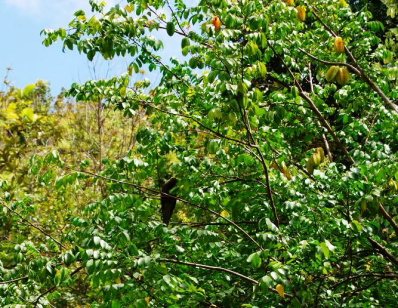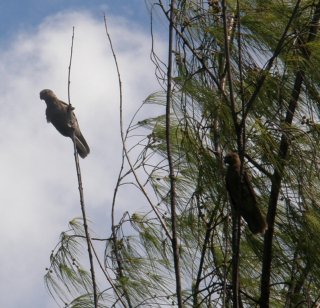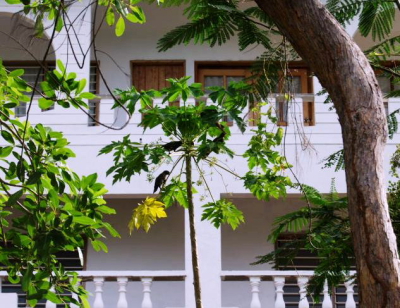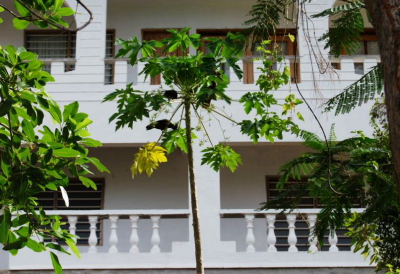The nice thing about black parrots is that they have taste. Not in the fashion sense - they are a distant cry from the catwalks of the neo-tropical birds, and their table etiquette needs work, but as far as food goes these psittacines have it down to a fine art. To get an inkling of perhaps why parrots enjoy certain fruits - do black parrots have a refined palate? -and not others, I sampled some food plants that were most frequently on the menu. Cocoplum (Chrysobalanus icaco), although numerous and listed as a food source does not appear to be eaten at all and tastes as if you have bitten into a rather soggy bag of flour, but I have repeatedly seen birds around bilimbi fruit (Averrhoa bilimbi), which although bitter is very juicy and refreshing . Of course mangos are a great favourite - who doesn't like mangos - and at the top of the list seems to be star fruit, which is very yummy and I urge you to go out and try one if you can. The parrots and I do have a difference in opinion about conifer cones, though.
Black parrots feeding on star fruit.
Photo courtesy of Usis Samedi from Seychelles Island Foundation
Black Parrots on island Pine tree (Casurina species).
Photo: Ellen Walford
In the past few weeks, I have been visiting cultivated areas away from the forests, mainly gardens and small private farmland. Praslin island has a small human population of just 7,500 - many of whom are employed in the tourism industry. Tourism is one of the main money earners in the Seychelles, and most visitors escape here to its stunning world famous beaches and tranquil pace of life.
Seychellois people for the most part are very house proud, and their gardens are a rainbow of colours, often lined with Crinum lilies - massive white and magenta lilies which remind you of those peppermint striped candy canes you get at Christmas. Although most garden plants are not native to the Seychelles, they none the less look as if they belong in this exotic setting. Bright crimson hibiscus, soft pink frangipani and mauve bougainvillea contrast beautifully with lime green breadfruits set against darkly verdant tree leaves. Parrot flowers (my favourite for obvious reasons) add splashes of bright artificial orange on spiky flowers, which using your imagination could be a parrot with a very funky hairdo. The national flower of the Seychelles, called the Tropicbird orchid on account of its white wing-like sepals and protruding long slender green spur can also be found nestled between rocks or larger bushes.
The agreeable climate here makes it ideal for growing a large array of fruit locally for relatively little expense, so most homesteads boast at least a couple of papaya, mango and banana trees. The more enterprising go further to grow fruit on a commercial scale adding guavas, passion-fruit, oranges and lemons. Less familiar fruits like breadfruit, jamalac, golden apple, star fruit and the massive ungainly jackfruit are also grown. However, a lot of these delicacies never make it into nearby fruit bowls. Although fruit production on a broad scale is little affected by the resident wildlife, the combination of giant fruit bats with appetites to match, black parrots who are mostly after seeds, common mynah birds who will eat anything they can get, blue pigeons and whatever other critter can get there in time (even the hordes of giant African land snails manage), leaves remarkably few of the more palatable fruit like mangoes and star fruit unblemished.
Papaya trees attract Black Parrots who feed on the flowers.
Photos courtesy of Usis Samedi from Seychelles Island Foundation
Taking all this into consideration, I have been amazed at the hospitality and warmth with which I have been received when house owners have been asked, somewhat tentatively at first, if we can possibly have access to their land as we are doing a study on the black parrots. Faces become animated and they go off into high speed Creole about which specific trees the parrots feed from, what time of day is their favourite to come to this particular spot, and where one pair nested in 1985 until the old tree fell down. Some commercial farmers shrug when I mention their potential losses at the market and put it all down to nature. A lot of them are Rastafarian, and I wonder if that peaceful philosophy has anything to do with it.
On a particularly warm day we were measuring various habitat bits and bobs on a high footpath with a magnificent view all across the island, accessed through the last house at the top of the hill. It was so hot that as soon as you drank any water it seemed to just run off you again, and my field assistant and I took turns darting into pocket handkerchiefs of shade provided by the stunted thief palms. Needless to say, neither the view nor the habitat was appreciated. We were just debating who should climb all the way down and refill our water bottles when the boy from the farm below appeared with a bag at least half his size full of passion fruit, guavas, papaya and bananas and two chilled bottles of water that his dad sent up. Of course it was only polite to accept.
On another occasion when I was alone visiting some sites on the south of the island, a farmer whose land I was just about to leave insisted that upon my return at 3:30 that afternoon he would have a special Creole dessert waiting for me. Not one to argue, I smiled and said that would be lovely, pretty bowled over by the fact that a.) he would do such a nice thing and b.) that he thought I looked like I needed feeding up. Not quite sure to expect, I arrived within the allotted hour which for the Seychelles is pretty good, to be presented with a large Tupperware container and a fork. The old boy obviously expected me to consume at least half then and there, so I took a large bite and was delighted with the result. It was gorgeous - fresh coconut milk and spices obviously - but the main part was a mystery. When I said so, he presented me with a large sack of the main ingredient to take home - sweet potatoes! Not the lightest thing to carry about in the field with you, the proverbial sack of potatoes.
A couple of days later I was scrutinizing a group of parrots feeding on some papaya flowers, and I'm convinced now that their good - natured faces and constant joyful whistles reflect their general contentment with life in general and their human company in the Seychelles. I know how they feel.




































